|
|
Post by Gokhan on Oct 13, 2008 17:51:28 GMT -8
Here is a brief history of the Expo Line:
The line was originally built in 1875, with the name “The Los Angeles & Independence Railroad.” Southern Pacific bought it in 1877 and later leased it to electric-railway companies after it was electrified in 1908. These electric railroads merged under the name of Pacific Electric in 1911. It was known as the “Santa Monica Air Line” for most of the history, providing freight and passenger service between Los Angeles and Santa Monica. Pacific Electric discontinued the passenger service on the Santa Monica Air Line in 1953. Southern Pacific continued the freight service, with the last freight service to Fisher Lumber in Santa Monica taking place in 1987 and to the Culver Junction circa 1989. Metro purchased the line from Southern Pacific in 1990 for future public-transit use.
Alan K. Weeks has recently sent me very rare, never-before-seen photos of the Air Line, which he took himself on Kodachrome slides in 1953, when he was a 21-year-old railfan. The electric-train service on the line was discontinued and the overhead wires were removed in the same year. In this thread I will post these truly remarkable pictures of the Los Angeles history.
|
|
|
|
Post by Gokhan on Oct 13, 2008 18:02:28 GMT -8
We start the tour from the east toward the west at Amoco Junction, that is where the Expo Line would intersect the Blue Line near Long Beach Ave and E 25 St, if Metro had used this segment of the right-of-way. Note that this is an electric freight train, Engine 1622 westbound on the Santa Monica Air Line just west of Amoco Junction. Dec 13, 1953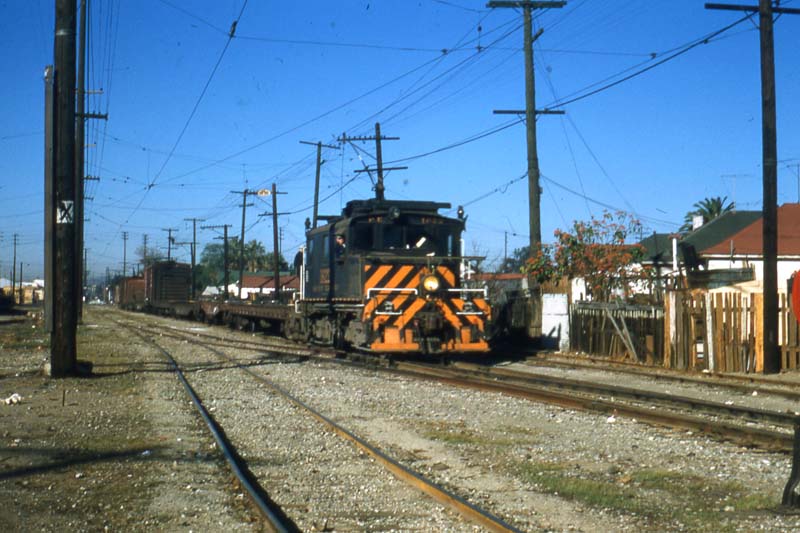 Full resolution Full resolution |
|
|
|
Post by Gokhan on Oct 13, 2008 18:13:18 GMT -8
Here we are at USC now. Mudd Hall of Philosophy in the background by Trousdale is still exactly the same after all these years. This is the P.E. Car 1299 on a charted club trip. The line was de-electrified one month later. This was a private car that belonged to the officials of the P.E.R.Y. It had leather chairs, a kitchen, bathroom, and carpets. September 27, 1953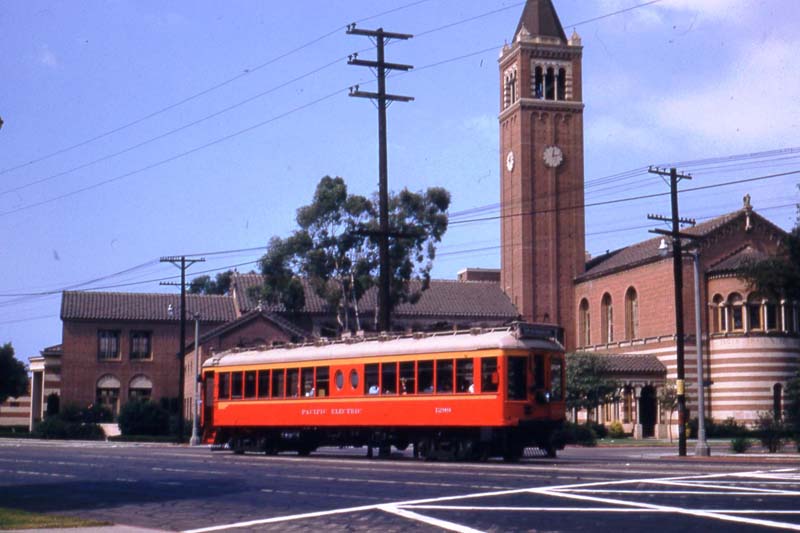 Full resolution Full resolution |
|
|
|
Post by Gokhan on Oct 13, 2008 18:32:41 GMT -8
This is PERY Car 1299 eastbound on Exposition Blvd at 11th Ave/Degnan Blvd siding, east of Crenshaw Blvd. Note the Circus train on the siding. According to Alan they used to have the circus every year at Washington and Hill Streets. They would put a huge tent up on vacant land. Billy Graham had his first Tent meeting there in 1949, which the photographer attended at age 17. September 27, 1953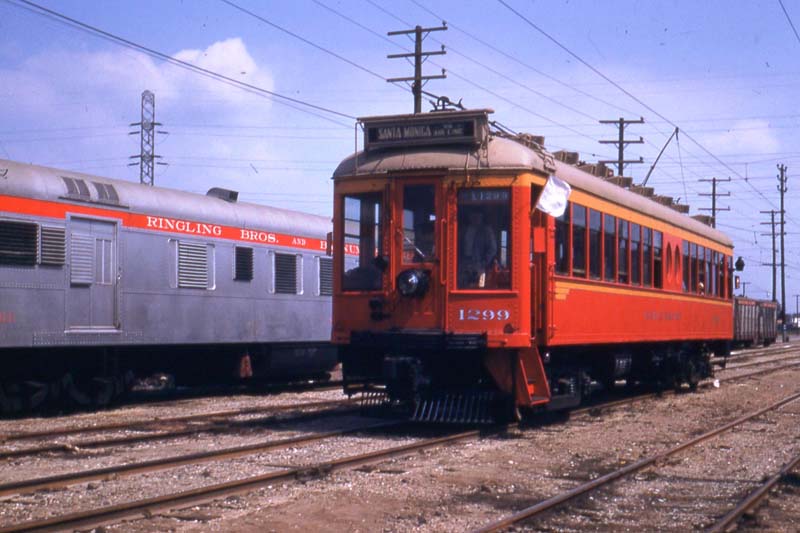 Full resolution Full resolutionPERY car 5125 at the same location. September 27, 1953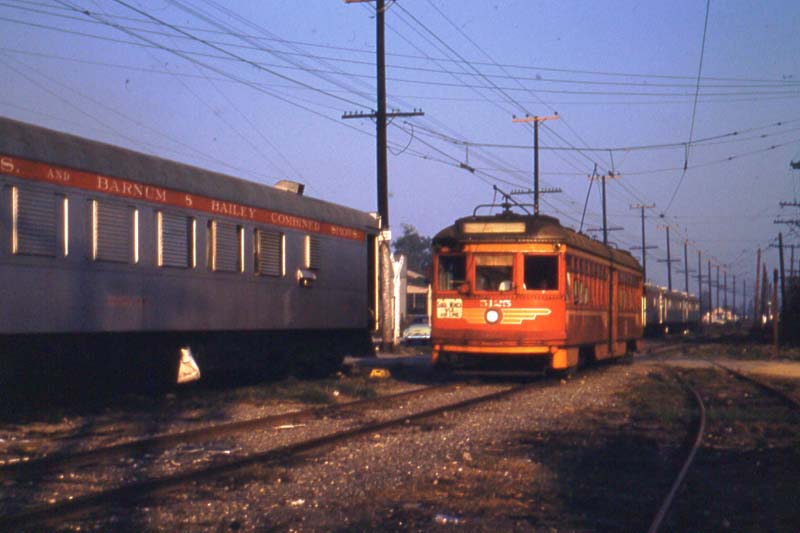 Full resolution Full resolution |
|
|
|
Post by Gokhan on Oct 13, 2008 18:41:51 GMT -8
We are now at Venice/Robertson, that is Culver Junction. This is P.E. electric-powered Engines 1603 and 1625 meeting a westbound electric freight train at Culver Junction in Culver City. December 13, 1953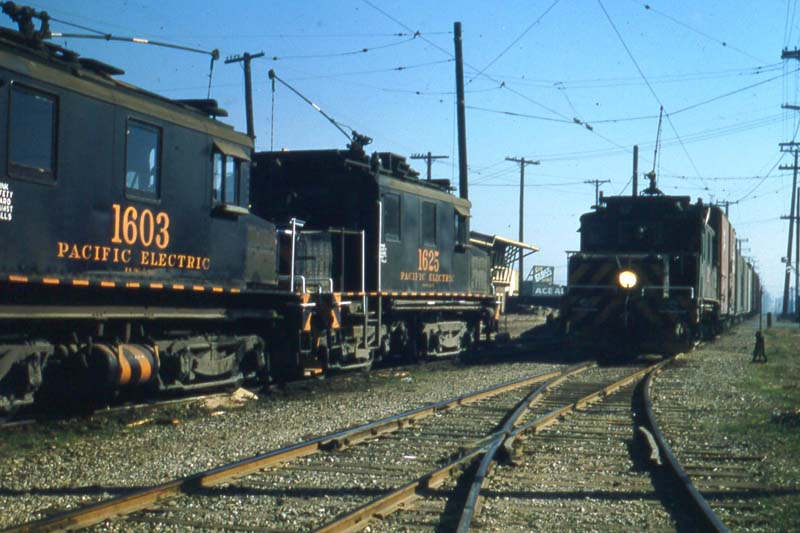 Full resolution Full resolution |
|
|
|
Post by Gokhan on Oct 13, 2008 18:45:41 GMT -8
This is also near Venice/Robertson, i.e. Culver Junction. PERY Car 5117 apparently westbound on the Santa Monica Air Line at Venice and Robertson. July 17, 1953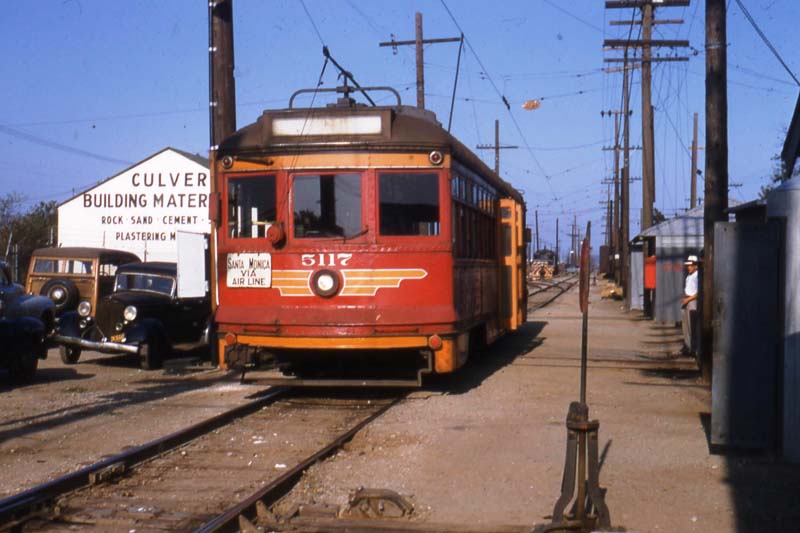 Full resolution Full resolution |
|
|
|
Post by Gokhan on Oct 13, 2008 19:01:23 GMT -8
Now we are at the Palms Station, commonly known as Palms Depot. The station building would be facing the freeway directly behind the northwestern corner of the Price Self-Storage facility today, which was the Great Depot Grounds then. This is near Vinton Ave and National Blvd in Palms. The station was saved from condemnation in the 70s and now serves as the visitors center of the Heritage Square Museum. The palm trees on the left that gave Palms its name were wiped off by the Santa Monica freeway built in 1963. So, this is P.E. Car 5117 westbound at Palms Depot on a chartered trip. Note that the Air Line was the last Pacific Electric passenger line to be abandoned. July 17, 1953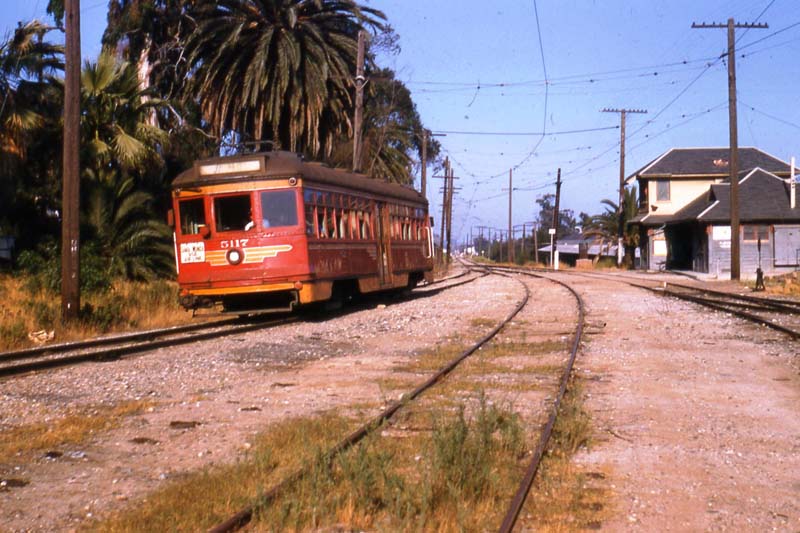 Full resolutionMore to come tomorrow, including Cheviot Hills and West LA. Full resolutionMore to come tomorrow, including Cheviot Hills and West LA. |
|
|
|
Post by bobdavis on Oct 13, 2008 19:52:13 GMT -8
PE 1299 is preserved at Orange Empire Ry. Museum. It needs some electrical work before it can be self-propelled again, but it has run as a "trailer" coupled to our PE "Blimps".
Regarding the electric locomotives, PE 1624 (built by PE in Torrance like the units shown in the photos) is preserved in running condition and is usually operated during PE weekend in June.
|
|
|
|
Post by Gokhan on Oct 14, 2008 11:26:59 GMT -8
Now we continue the tour toward Santa Monica. Here we are still in Palms, looking west from Palms Depot, with an eastbound train, PERY Engine 1617, approaching. This is a block east of Motor Ave, near Vinton Ave. The area on the right side with Palms trees were replaced by the freeway in 1963. This section of the right-of-way is above the street level from National Blvd, due to natural topography. Palms (the neighborhood, not the trees) is to the south of the tracks. Note that the tracks are bending toward the bridge over Motor Ave. June 20, 1953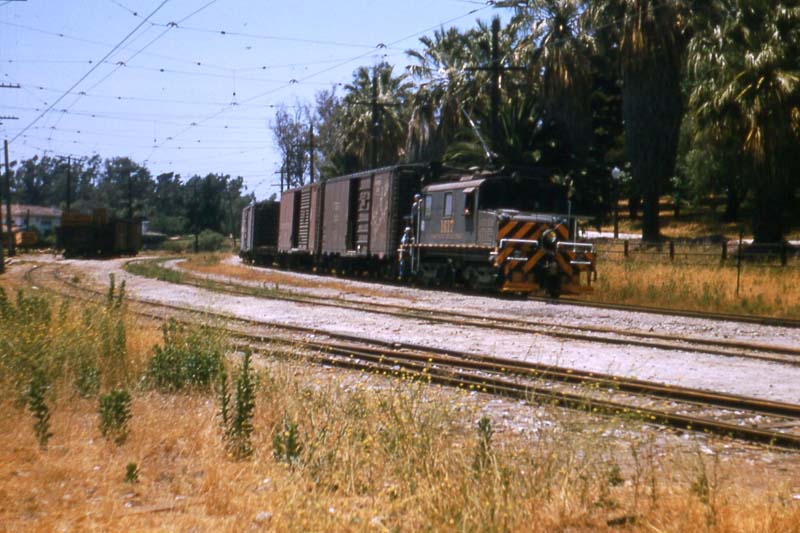 Full resolution Full resolution |
|
|
|
Post by Gokhan on Oct 14, 2008 12:00:26 GMT -8
This is a great shot of P.E. Car 1299 on a charted club trip on the former Motor Ave bridge. The light-rail car is heading west and we are looking north on Motor Ave. You can see the gates of Vista Del Mar Orphanage, where the Phase 2 meetings for the Expo Line are held, in the background. Note the right-of-way crossed Motor Ave where the westboound lanes of the freeway crossed today, and the tracks were near the northern edge of the right-of-way. Hence this former bridge used to be near the northern edge of the freeway. When the freeway was built, this old bridge was removed and the tracks were put along the southern egde of the freeway near Motor Ave, with a new bridge over Motor. The tracks now go under the freeway in a 25-ft-wide, 350-ft-long reinforced-concrete box called Palms Overhead 700 ft west of Motor Ave that was built when the freeway was built. After they emerge from under the freeway, they follow the exactly the same old right-of-way in an exactly the same old trench adjacent to the Cheviot Hills area. In addition to the Palms Station a block east of Motor Ave at Vinton Ave, there was a stop immediately west of the Motor Ave bridge called "Winship." The stop to the east of the Palms Station was at Bagley Ave and called "Reed." The line was de-electrified one month later. This was a private car belonged to the officials of the P.E.R.Y. It had leather chairs, a kitchen, bathroom and carpets. Sept. 27, 1953 Full resolution Full resolution |
|
|
|
Post by Gokhan on Oct 14, 2008 12:10:33 GMT -8
This seems to be a train (Engine 1607) heading east toward Palms near the western portal of the freeway tunnel today (then no tunnel or freeway). On the right side of the picture is a restricted-used sewer easement between the tracks and houses in the southernmost part of Cheviot Hills. There is a possibility of including a bike and pedestrian trail along the restricted-use easement today, since the tunnel is not wide enough to accommodate it. On the left side are the houses that were wiped of by the freeway. June 20, 1953 Full resolution Full resolution |
|
|
|
Post by Gokhan on Oct 14, 2008 12:32:33 GMT -8
This is one of my favorite shots. It's a great shot of the Northvale Rd trench in 1953. Since Cheviot Hills is built on hills, the tracks had to go in a trench next to Northvale Rd (previously named Exposition Blvd) so that they could maintain a level grade. Therefore, this trench was built in the early years so that the freight trains wouldn't have to negotiate grades more than 10%, which they couldn't negotiate anyway. The location of the Electric Locomotive 5117 headed west is near Clarkson Rd and Northvale Rd, with a white wooden barrier at the dead end of Clarkson. The visible section of the train is exactly next to the Palms Park today, the green area on the right then. The fifth car is near the pedestrian bridge near Dunleer Dr connecting Cheviot Hills to Palms Park. The pedestrian bridge didn't exist then and I heard the neighbors used to climb down the trench, walk across the tracks, and climb up the trench to go to a school at Overland Ave on a daily basis when they were kids. The houses along Northvale Rd on the left side of the picture were built in 20s through 40s and they are the oldest houses in the Cheviot Hills area, attracted by the rail line. The houses seen on the right side of the picture were wiped off by the freeway. A noticable difference from today is the absence of any landscaping along the slopes of the trench then. Today the slopes of the trench are covered with many trees, bushes, and flower plants. The trench is also fenced today and access is only possible if you enter the right-of-way further west from Overland Ave. July 17, 1953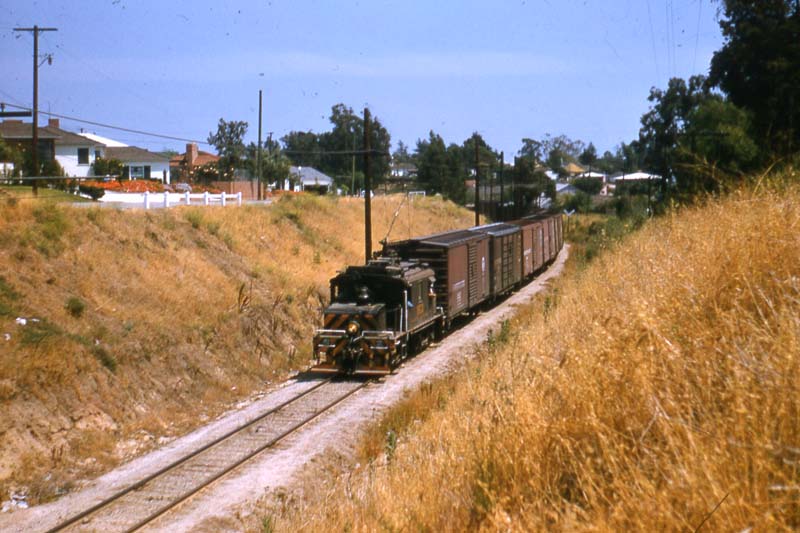 Full resolution Full resolution |
|
|
|
Post by Gokhan on Oct 14, 2008 14:10:23 GMT -8
Here is another trench photo. PERY Car 5117 westbound in the Northvale Rd trench. It might be further west toward Overland Ave than the train in the previous photo. July 17, 1953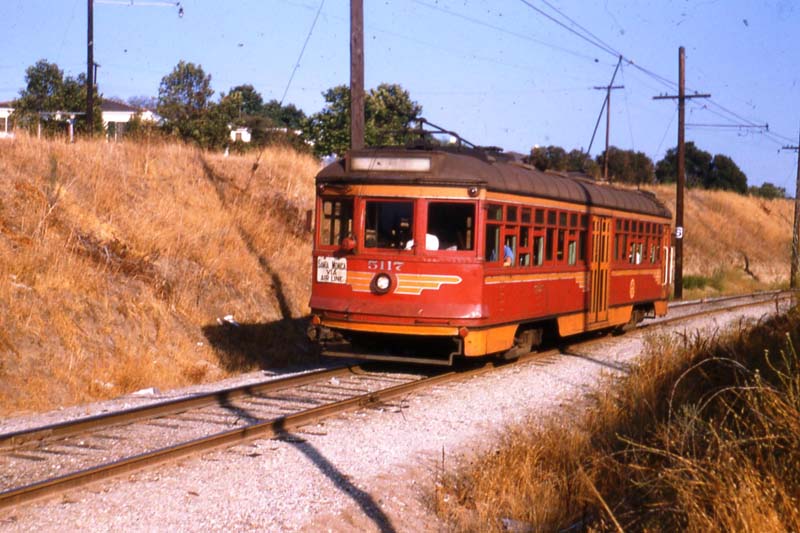 Full resolution Full resolution |
|
|
|
Post by Gokhan on Oct 14, 2008 14:41:10 GMT -8
A picture tells a thousand stories. We are now at the "Home Junction," that is Exposition and Sepulveda. There was a spur on Sepulveda and the line continued all the way up to UCLA, to an area known as the Soldiers' Home, which is the VA today. Through this Sepulveda spur, the line also connected to the major railroad right-of-way on Santa Monica Blvd (partly paved over recently), serving the Beverly Hills area. The freight service through the Exposition Blvd right-of-way, Sepulveda Spur, and Santa Monica Blvd to Beverly Hills continued through mid 80s. Shortly before the 1984 Olympics, a commuter-train service between USC and UCLA was proposed, dubbed the "Olympic Line." This Metrolink-like line would have a capacity of close to a million passengers a day, aimed at shuttling the people back and forth between Coliseum and the UCLA area. The estimated cost of the line was only $2 million. Like many proposed lines in the 60s through 80s, it got killed in the last minute. Here PERY Car 5117 on a chartered trip is headed west, pictured just east of Sepulveda Blvd. Exposition Blvd is seen on the right. Military Ave is in the background. Note the wye turning north to Sepulveda Blvd. This is the Home Junction. This wye eventually joined the right-of-way on Sepulveda Blvd, which was on the west side of the street. July 17, 1953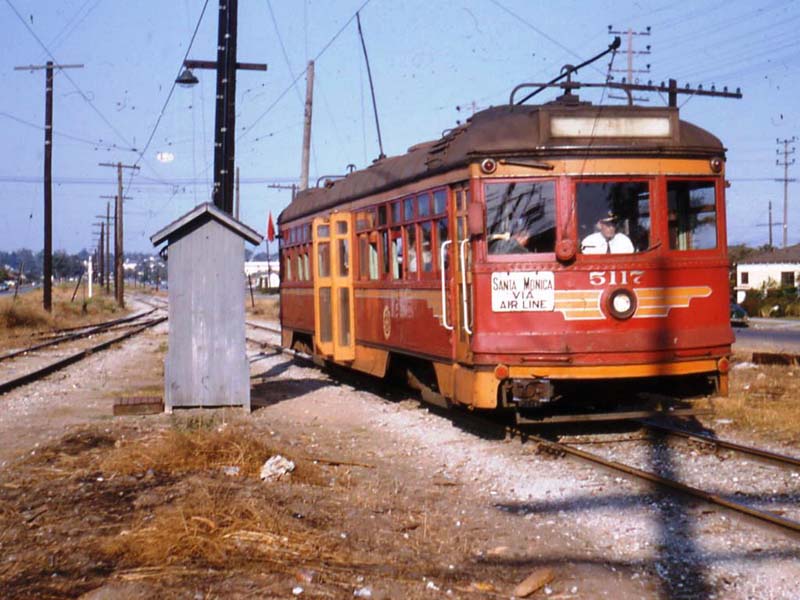 Full resolution Full resolution |
|
|
|
Post by Gokhan on Oct 14, 2008 15:23:51 GMT -8
These two pictures conclude the Air Line pictures Alan Weeks sent to me. They are near the "Ocean Park Car House" in Ocean Park in south Santa Monica, the terminus of the "Air Line." Interestingly they built a huge amusement park named "Pacific Ocean Park" at this location on the beach, aimed at competing with Disneyland, five years after the Air Line was discontinued. The amusement park itself didn't survive more than a decade and today all of its traces are completely gone. Actually the line didn't really end here at all but continued to Venice, Marina Del Rey, Westchester, and Inglewood, on a private right-of-way along Neilson Way, Main St, Electric Ave near Abbot Kinney, north of Marina Del Rey, along the entrance of the Marina Freeway, Jefferson Blvd, and Centinela Ave. This part of the line wasn't called the Air Line but Inglewood Line. The Inglewood Line terminated at the BNSF Harbor Subdivision right-of-way in Inglewood. Therefore, it was an Expo - Green and Expo - Crenshaw Lines connector. Wouldn't it be great if the Expo Line continued from Santa Monica all the way to Venice and even Inglewood, connecting with the Green and Crenshaw Lines? Unfortunately, some parts of the Inglewood Line right-of-way were sold to private entities by the city and the right-of-way is no longer fully intact today. Although, you could still see the remnant tracks along Electric Ave in Venice today. Most parts of this right-of-way today are city parking lots or empty but in some lots there is development. This is PERY Car 5117 again in Ocean Park near the end of the Air Line, or the beginning of the Inglewood Line. This was a Sunday charter trip and someone knew no regular trains ran on Sunday, so used the track for a parking lot. Photographer thinks that someone got the door open and they moved it out of the way. July 17, 1953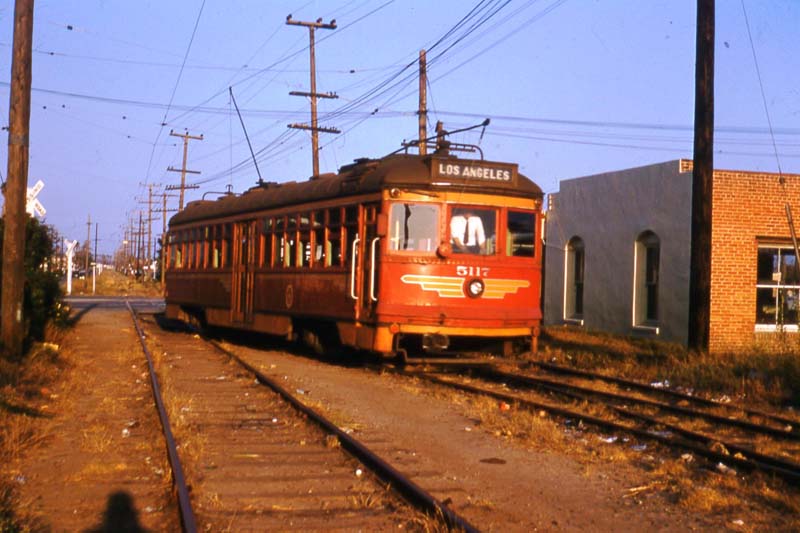 Full resolution Full resolution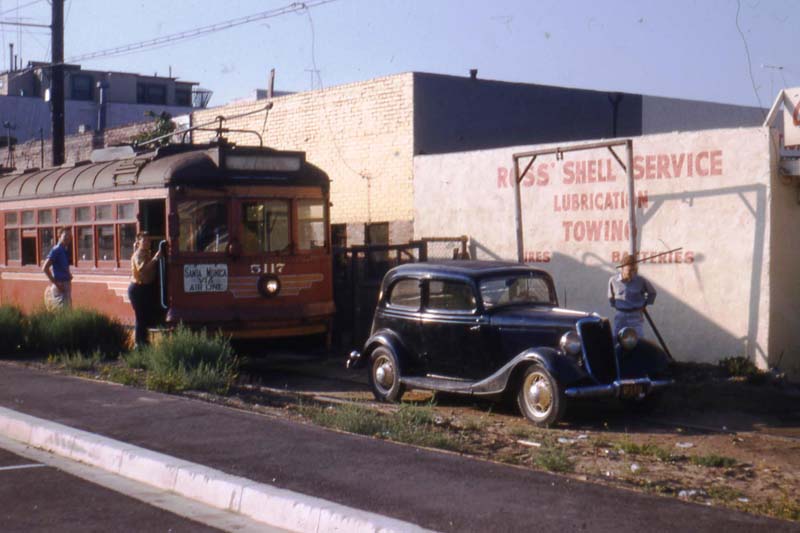 Full resolution Full resolution |
|
|
|
Post by Gokhan on Oct 14, 2008 16:28:21 GMT -8
Finally two more pictures from Alan Weeks, this time not From the Air Line but the Beverly Hills Line, equivalent of the Red/Purple Lines extension then. The first is at Canon Dr and Santa Monica Blvd in the heart of Beverly Hills, near where Burton Way joins Santa Monica Blvd. P.E. Electric Locomotive 1613 eastbound leaving Beverly Hills Station at Canon Dr. Note Hollywood Blvd Red car in the background. June 20, 1953 Full resolution Full resolutionThe second one is PERY Engine 1613 westbound on Santa Monica Blvd near Sepulveda Blvd on the old Beverly Hills Santa Monica Line. June 20, 1953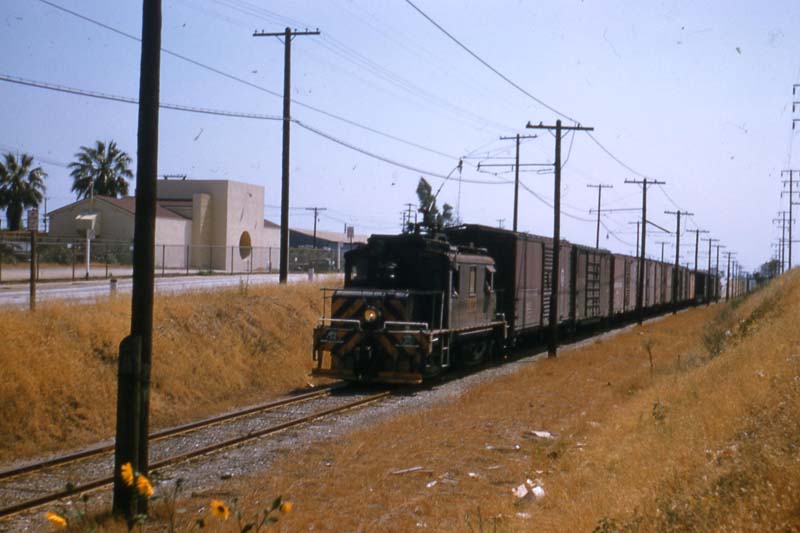 Full resolutionToday the old rights-of-way along San Vicente Blvd (both the eastern and western boulevards), Burton Way, Santa Monica Blvd, Venice Blvd, and Culver Blvd are all preserved. The San Vicente/Santa Monica Blvd right-of-way goes all the way through Brentwood to the sea in north Santa Monica, as a wide, unused median. Perhaps one day we will see less red tape, less NIMBYism, less fear of rail, more demand, more need, and more funding, and all these unused rights-of-way that crisscross the Westside will be used. Or, perhaps, things will get worse and it will be more and more difficult to build rail transit in the future. Full resolutionToday the old rights-of-way along San Vicente Blvd (both the eastern and western boulevards), Burton Way, Santa Monica Blvd, Venice Blvd, and Culver Blvd are all preserved. The San Vicente/Santa Monica Blvd right-of-way goes all the way through Brentwood to the sea in north Santa Monica, as a wide, unused median. Perhaps one day we will see less red tape, less NIMBYism, less fear of rail, more demand, more need, and more funding, and all these unused rights-of-way that crisscross the Westside will be used. Or, perhaps, things will get worse and it will be more and more difficult to build rail transit in the future. |
|
Mac
Full Member
  
Posts: 192
|
Post by Mac on Oct 14, 2008 17:53:48 GMT -8
Are there plans to preserve some of the old track and put them in a museum...(Orange Empire Probably)?
|
|
|
|
Post by spokker on Oct 14, 2008 19:14:25 GMT -8
At grade? Goodman is going to get in a time machine and kill the Santa Monica Air Line before it's ever built.
Consider these vintage photos... DOA.
|
|
|
|
Post by bobdavis on Oct 14, 2008 22:09:46 GMT -8
Just a correction in the electric locomotive comments: PE 1619 thru 1631 were the "home brew" freight motors with GE motors and controls. 1601 thru 1618 were Baldwin-Westinghouse units; none of them survived. There were some smaller Baldwin-Westinghouse unit in the 1590's, one of them is preserved in Argentina. Note that these freight motors shared the track with "Hollywood" cars--the FRA and/or the PUC would "have a cow" if any railway tried that today.
|
|
|
|
Post by Gokhan on Oct 15, 2008 16:39:43 GMT -8
In the 1988 movie Who Framed Roger Rabbit, set in 1947 Los Angeles, there is the following scene: 'Across the street, down-and-out Valiant tries to board Los Angeles' Pacific Electric "Red Car" electric trolley bound for Sunset Blvd., but is denied entry by the conductor (James O'Connell) when all he can come up with is his paper check. He joins a group of young boys already hitching a free ride on the back of the Red Car. [Valiant's comment to one of the dirty-faced boys is a tongue-in-cheek tribute to a vast system of electric trolleys that once criss-crossed the LA Basin: "Who needs a car in LA? We got the best public transportation system in the world."] At the trolly terminal, a cheap cardboard sign reading "Now a Cloverleaf industry" (a dark green sign emblazoned with a four-leaf clover insignia, symbolic of the coming freeway system) is hauled up over the existing "Pacific Electric - The World's Finest Public Transportation System" sign to replace it.'Los Angeles must be the most unique example of how much the character of a city would change (for the worse) when you got rid of the most comprehensive transit system in the world and replaced it with freeways. We all know how the city is today and this large set of the Pacific Electric Railway pictures tells a good story of how it was then.Pacific Electric Railway photo set(Make sure to set Info On on top of the page) |
|
|
|
Post by bobdavis on Oct 15, 2008 21:07:43 GMT -8
I wouldn't say "most unique", but LA did have more electric railway service than most of the cities that went all-bus. Some will hoist the "National City Lines did it" banner, but the real story is so much more involved than a mere change of ownership of the transit system. Southern California was a particularly fertile place to grow the automobile culture. Our climate meant that people could drive all year (in the old days, folks in cold climates would store their cars until the spring thaw). Cars could be run for many years longer where there were no harsh winters with road salt. We don't have as many geographical barriers as many cities have that force traffic into a few bottlenecks (e. g. the SF-Oakland Bay Bridge). Many of the people who settled here after World War II came from small towns were there was no tradition or habit of riding public transit. I'm old enough to remember when you could buy a usable car for a few hundred dollars, fuel it with 25-cent gas and keep it running with junkyard or Sears parts that you installed yourself in the "shade tree garage".
|
|
|
|
Post by whitmanlam on Oct 15, 2008 21:37:26 GMT -8
If you look at the old pictures, much of our Electric Railway did not have exclusive right-of-ways, they were street running trolleys, with numerous stops that were not practical for long distances.
Could not compete with the automobile in terms of speed or neighborhoods accessibility (We have alot of hills and valleys.)
When the suburban boom began, and the Electric rails could not follow those residents out to the suburbs, the money hungry politicians sold the track right-of-way as they stopped running the trains.
The problem wasn't the rails being killed off. The people abandoned public transportation for the car, and moved out of the city center in droves.
|
|
|
|
Post by Gokhan on Oct 15, 2008 22:26:14 GMT -8
If you look at the old pictures, much of our Electric Railway did not have exclusive right-of-ways, they were street running trolleys, with numerous stops that were not practical for long distances. Could not compete with the automobile in terms of speed or neighborhoods accessibility (We have alot of hills and valleys.) When the suburban boom began, and the Electric rails could not follow those residents out to the suburbs, the money hungry politicians sold the track right-of-way as they stopped running the trains. The problem wasn't the rails being killed off. The people abandoned public transportation for the car, and moved out of the city center in droves. Actually the first statement is mostly wrong and the second statement is totally wrong, in fact the complete opposite of the truth. Most Pacific Electric lines had dedicated rights-of-way. You are referring to the Downtown pictures, which are misleading you. Pacific Electric Railway is what drove the suburban boom on its very own. In fact, these lines were all suburban lines, and they were the equivalent of our freeway system today. If we didn't have Pacific Electric, we wouldn't have the suburban sprawl today. The following map will make you understand this. Pacific Electric Railway (click here to enlarge): So, basically the Pacific Electric lines were replaced by freeways. As a result, suburban people started driving instead of taking the train. |
|
|
|
Post by Gokhan on Oct 15, 2008 22:48:13 GMT -8
I wouldn't say "most unique", but LA did have more electric railway service than most of the cities that went all-bus. Some will hoist the "National City Lines did it" banner, but the real story is so much more involved than a mere change of ownership of the transit system. Southern California was a particularly fertile place to grow the automobile culture. Our climate meant that people could drive all year (in the old days, folks in cold climates would store their cars until the spring thaw). Cars could be run for many years longer where there were no harsh winters with road salt. We don't have as many geographical barriers as many cities have that force traffic into a few bottlenecks (e. g. the SF-Oakland Bay Bridge). Many of the people who settled here after World War II came from small towns were there was no tradition or habit of riding public transit. I'm old enough to remember when you could buy a usable car for a few hundred dollars, fuel it with 25-cent gas and keep it running with junkyard or Sears parts that you installed yourself in the "shade tree garage". It's certainly true that this is not just a conspiracy in which GM and GoodYear bought PE and dismantled it. But it's not good Southern California weather to blame either. In fact most people agree that bad weather encourages driving and good weather public transportation, since public transportation involves walking and driving isolates you from the weather. It's not because cars and gas were cheap in the 50s either. You can still buy a car for $200 and make it work with junkyard parts, working on it under the shade of a tree. In fact, I would say, cars and gas are much cheaper than in the past, especially considering the fact that people make much more money than in the past. This is evident from the fact that almost everyone owns a car in LA today. The point I was trying to make is how the character of the city changed. How many people were taking public transportation then and how many now. Middle class taking public transportation then but no so much now. People having a sense of community then but isolating themselves in their cars and preferring an individualist lifestyle now. Just look at the pictures with lots of people in the stations, on the streets then, and you will see the fundamental change in the character of city. In fact this is very drastic. There are very few places in the world today than Southern California, in which people are so isolated in a city that they live in. Who is to blame though? Blame shortsightedness. Blame the government on not helping these companies modernize their systems, subsidize them, etc. But most of what happened is not just spontaneous. Remember that it costs as much money, probably more, to build freeways. The government built freeways for the public for free but they chose not to build any public transit. So, why did the government decide on replacing the rail lines with freeways free of charge? This is a long debate. There are many factors in my opinion. This is certainly not something that happened in Southern California alone but throughout the world. The end of World War II played a a role, which fueled capitalist movements. There was a strong belief and desire in individual wealth. There was racial segregation, which didn't favor public transit. But it all comes to the fact that people couldn't imagine what the situation would be in a few decades. We, at the present day, also cannot imagine the situation in a few decades. Things can change drastically. Public transportation can become a government mandate to the point that private cars are almost restricted. World can come to an end. Who knows. Perhaps it will be just more of the same during our lifetimes. |
|
|
|
Post by wad on Oct 16, 2008 4:06:18 GMT -8
I wouldn't say "most unique", No one should say "most unique." By definition, unique is a characteristic of one and no other. OK, enough pedantry for now. My two cents on Pacific Electric, and reflecting that I was not even alive to see streetcars in L.A.: Efforts today should undo the mistakes we made in the past, not to win a past battle that was lost. In general, we didn't lose the streetcars because of a conspiracy. That was an effigy that took a life of its own because the people who had a chance to do right didn't. Sorry, it wasn't GM that killed off the streetcars. It was Angelenos who began a pattern of what I like to call "L.A.ing up things." L.A.ing up means the capability of Los Angeles -- collectively from leaders to ordinary residents -- to make the choices wrong. Making the wrong choices implies that had another alternative been pursued, it would have been correct. But, reversing those words, making the choices wrong means no matter what we do, we have a near certain chance of dropping the ball. Ripping out the streetcars was a mistake, but it's not because we lost the vehicles. It's because we lost the rights of way. Few people know this, and nobody wants to admit this, but buses were the technological successor to the streetcars. They both do the same things, but buses made the most sense because they are more economical. The bus conversion began at a time when streetcar vehicles and infrastructure were coming at the end of a life cycle. At the same time, ridership had started to see its decline. So it made business sense to replace decaying streetcar stock with buses. The problem was that when we lost the rights of way, public transit still left a persistently high ridership in L.A. We were all-bus for about 30 years, and it led to slow and steady ridership declines. This sent a feedback loop that transit should not be invested in because the ridership was on a downward spiral with no bottom. However, we maintained remarkably high passenger yields per vehicle. L.A. stuck with buses because of transit's downward trend, but it ignored the vehicle productivity. Had these rights of way been preserved, we could have maintained some form of high-capacity transit service. L.A. didn't expand public transit because it perceived it as a diminishing return, while at the same it was hamstrung by using limited-capacity buses for a much higher-capacity ridership. All of our efforts, including the 1980 and 1990 sales taxes, have been rear-guard efforts to correct for the 30-year "dark ages" between the last streetcar and the introduction of the Blue Line. Whatever credit we have is because of riders and advocates snatching success from the jaws of failure. |
|
|
|
Post by whitmanlam on Oct 16, 2008 7:46:33 GMT -8
The entire culture was changing after World War II. People with families wanted to live "The American Dream". Buying a large house, with a big back yard, and a car in the garage. Corporate America sold them affordable houses, on cheap land, with cheap cars that run on cheap gas. Who could resist that ?
Even today, young couples with children are dreaming that dream. It's not nearly as affordable, but it's still the dream.
Though ridership remained high, it was mostly due to the lower class people L.A. Not exactly the crowd that politicians cared most about. Politics had a little to do with it. But ultimately, it was the choice of the middle class, the suburban mindset, a booming Detroit "car culture" that swept the country and drove the P.E. rail into irrelevancy and bankruptcy.
|
|
|
|
Post by kingsfan on Oct 23, 2008 8:50:18 GMT -8
Great pics, Gokhan. What a resource for local historians.
|
|
|
|
Post by darrell on Sept 12, 2009 23:26:19 GMT -8
Here are three new (to here) photos. Credited to the Ralph Melching collection, they must be at least second-generation duplicates. Added credit: The Pacific Railroad Museum, Pacific Railroad Society.  An early view of the Air Line passing what is now Foshay Learning Center on the left.  A special Pacific Electric car crossing the Ballona Creek bridge, before the National Blvd. bridges existed. 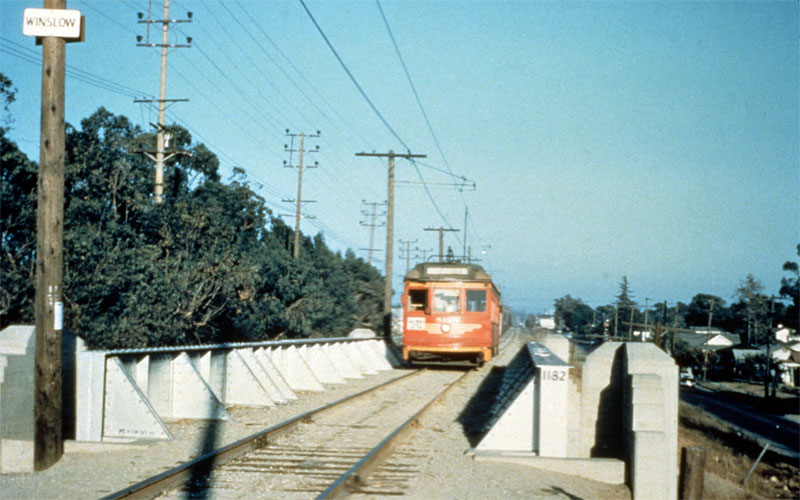 This appears to be crossing National Blvd., establishing that this bridge pre-dates the freeway that is now just to the left. |
|
|
|
Post by Gokhan on Sept 13, 2009 9:20:50 GMT -8
Wow, a real creek, not a concrete channel!
Did you notice the dual-gauge tracks on the bridge? I wonder if they are from the steam-operation days? The PE 1299 in the photo was a special business car with leather seats and other fancy decoration. It's now in OERM:
The Winslow Station photo confirms that National Blvd in Palms was grade-separated even back in those days. This bridge doesn't appear to be exactly at the same location as the current bridge according to the historical aerials. This is because National Blvd was moved about 50 ft west to join straight with Palms Blvd when the freeway was built. So, I wonder if they moved the same steel bridge onto new abutments when they built the freeway or they made a new steel bridge.
|
|
|
|
Post by James Fujita on Sept 13, 2009 10:17:06 GMT -8
Wow, a real creek, not a concrete channel! Did you notice the dual-gauge tracks on the bridge? I wonder if they are from the steam-operation days? are you sure those are dual-gauge tracks and not a safety guard rail? the P.E. was standard gauge, wasn't it? |
|